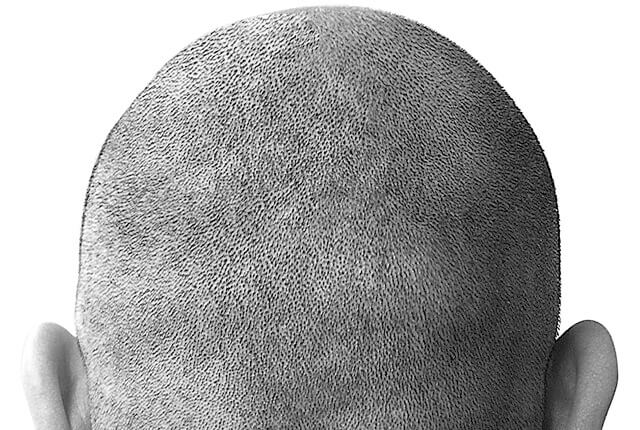Find out your risk of developing Male Pattern Hair Loss
Harley Street based Dr Farjo is a leading UK trichologist and a medical director of the Institute of Trichologists. He has recently introduced the first medical ‘lab screening test’ for male pattern hair loss in to the UK, known as the Hair DX Test. We caught up with him to find our more about the test and dispel a few myths on the cause of male pattern baldness.
GJ: What causes hair loss?
DRF: Male Pattern Baldness (MPB) is the cause of hair loss in men in over 90 per cent of cases. Male Pattern Baldness is defined as hair loss at the front, top and/or the crown/vertex of the scalp (non-permanent area). The back and sides of the scalp are spared and usually grow hair for life (permanent area).
The hair root has a life cycle. In simple terms, this cycle consists of a growing phase and a resting phase. Before hair loss sets in, the growing phase lasts up to seven years and the resting phase lasts three to four months. Genetic hair loss causes the life cycle phases to go in reverse, i.e. the growing phase becomes shorter and the resting phase longer. Eventually, the hair grows very little or not at all.
The cause of MPB is the presence of hormone receptors in the hair roots of the non-permanent area. No such receptors exist in the permanent area. These receptors attract the male hormone dihydrotestosterone (DHT) and, as a result this starts the hair loss process. The number and location of these susceptible hairs is determined by inherited genetics from both or either parents. The scalp is the same all over and is usually rich in blood supply and therefore, contrary to commonly heard myths, MPB has nothing to do with lack of blood supply.
Other forms of hair loss include traction alopecia, which is caused by tight braiding or pulling on the hair and is temporary if the traction is short-term, but becomes permanent with prolonged trauma. Usually the situation that we see is a bald area at the very front of the hairline. Hair transplant surgery can restore hair permanently, as long as the cause of the problem ceases.

Chemicals, such as those used in hairdressing, can cause hair breakage but not true hair loss. However, if the substances are used incorrectly, they can actually cause damage to the skin and to the hair roots, thus causing permanent hair loss. Similarly, burns to the skin can destroy the hair roots and cause a bald patch. In both of these cases, follicular unit transplantation may be a treatment option but this depends on the amount of scar tissue present.
Severe illness, surgery, medical conditions (such as thyroid abnormalities or low blood count), rapid weight change or emotional stress can also cause or accelerate hair loss. Once the stress is removed, hair usually grows back within a few months.
Alopecia areata is a condition that is thought to be caused by the body producing substances (antibodies) that prevent the hair roots from producing hair. The condition usually appears as one or more isolated patches of complete baldness. In more severe forms, there is total baldness of the scalp (alopecia totalis) and, in extreme cases, total loss of all body hair (alopecia universalis). Sometimes medical treatment is successful in treating the less severe forms of the hair loss due to alopecia. In many cases, the condition clears up by itself, but may recur at a later stage.
Additionally, there are over 100 drugs known to cause hair loss including some forms of blood thinning drugs, thyroid medications, chemotherapy for cancer and contraceptive pills. Again, the effects are reversible once the drug is changed or stopped. Localised skin problems such as eczema, psoriasis, scarring conditions and infections can also cause temporary or permanent hair loss. If the hair loss is permanent, surgery can be used to restore hair to the area as long as the underlying skin condition has been successfully treated.
GJ: Why do you think men have the Hair DX test?
DRF: The Hair DX screening test is often taken by men who are concerned about hair loss, or who have a family history of baldness. The test is simple and completely non-invasive test. It can determine whether an individual is genetically pre-disposed to pattern baldness, identifying those at high risk before they begin to lose their hair. We’ve found that the test often helps them to make a decision about whether or not to undergo medical or surgical treatment.
GJ: What are its benefits?
DRF: The genetic test enables risk of pattern baldness to be assessed before hair loss occurs. Earlier intervention and treatment give patients the best chance of success, as the only FDA & MHRA approved medications to combat hair loss – Minoxidil (Regaine Foam) and finasteride – are most effective at stabilising hair loss rather than stimulating re-growth.

GJ: How does the test work?
DRF: The test for male pattern baldness provides information on the presence of a specific gene variation on the X chromosome. Men who test positive are at high risk of developing early-onset male pattern baldness. A smaller test score is associated with a higher risk for significant hair loss. An additional newer test now enables us to assess the likelihood of a positive benefit from the drug finasteride (Propecia).
GJ: How accurate is it?
DRF: Male pattern hair loss is a polygenic condition meaning there are multiple genes involved, but only one gene (AR) has been definitely identified. Therefore, the results of the test reflects this in that a positive result means there is a 70% chance of significant baldness
GJ: How is the test carried out?
DRF: The genetic test involves taking a saliva swab from the inside of the cheek. This is then sent to a lab, where the DNA is analysed.
GJ: What if the results come back positive?
DRF: In this case the patient may wish to consider using one or both of the above medications to prevent significant future loss
GJ: What would you recommend for someone whose results come back positive? Regaine Foam (Minoxidil) or a hair transplant?
DRF: If there is no significant loss or hardly any, then see my previous answer. A transplant is only indicated if one can make a definite and visually significant difference i.e. there is a visually significant area of scalp with hair loss
GJ: When should a man have a hair transplant? (until one is fully bald or receding, but what if it recedes further – will a costly second transplant be required?)
DRF: We’d advise anyone considering a hair transplant to go and see a specialist for personal guidance. Patients should be provided with a tailor-made treatment plan that is designed specifically to obtain the results they want, as well what is achievable with their level of hair loss. Advice should not only consider hair transplant surgery, but also before and after treatment and steps that can be taken. Future loss possibility also contributes to advising about the best timing for a transplant.







